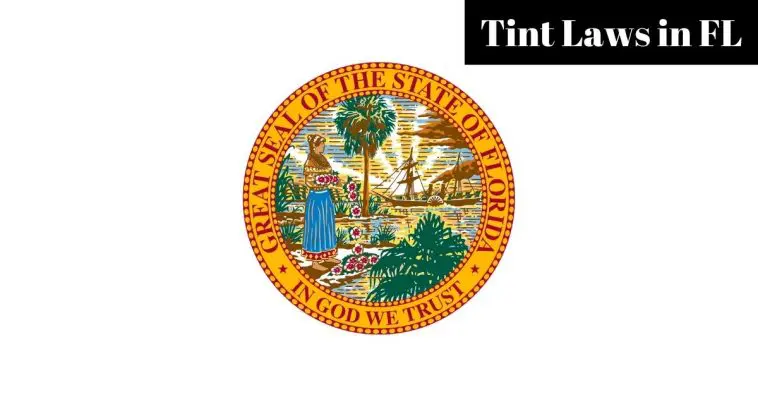If you’ve purchased a car recently, you’d want to be well aware of the laws that govern whether or not you’re allowed to tint your windows and how much you’re allowed to tint them.
Since window tint laws vary from state to state, we’d strongly recommend you go through the tint laws in the state of Florida carefully before you tint your windows.
In doing so, you’ll be able to ensure you avoid a run-in with the authorities or paying a hefty fine. In the following sections, I’ll take you to everything you need to know about the tint laws in the state of Florida.
TABLE OF CONTENTS
Are You Allowed To Have Tinted Windshield And Windows In Florida?
Since Florida is a fairly sunny and hot state, it’s no surprise that the authorities do allow you to tint your windows – within certain limits. You can tint your windshield in Florida, but only above the AS-1 line.
Anything below this is considered illegal and could get you into trouble. As for windows, Florida is more relaxed with the window tinting limits than other states because – as discussed above – it’s quite a sunny state.
So long answer short, yes, you can tint your windshield and windows in Florida.
What Is The Darkest Tint You Can Legally Get In FL?
Florida tint laws clearly define the amount of tint you can get on the front and rear windows of your car. Vehicle-owners in Florida must have a tint that allows over 28% of light to pass through the front of the vehicle.
As for the back, the specified minimum limit is 15%. However, this is for passenger vehicles. Multi-passenger vehicles have a more lenient limit for the rear windows. Their rear windows are allowed to have a tint that allows only 6% of light to pass through.
Is 20% Tint Illegal In FL?
For the front portion of your vehicle, yes, a 20% tint is considered to be illegal in Florida. However, you’re allowed to have a tint as low as 15% for the back of your passenger vehicle. As for an MPV, the limit is 6%.
Can You Get Pulled Over For Tinted Windows In Florida?
Yes, you can very much get pulled over if you have tinted windows in the state of Florida. This is mainly done as a safety precaution if an officer feels they cannot see clearly inside your vehicle.
However, that doesn’t mean you’ll get pulled over every single time you drive by a cop with your tinted windows. Having tinted windows coupled with some suspicious behavior on your end may compel an officer to pull you over.
Many officers even carry a portable light meter. Such a device can measure the percentage of tint you’ve got so you won’t have to worry about getting pulled over if you stay within the tinting limits.
How Much Is A Tint Ticket In FL?
A tint ticket in Florida can cost you as much as $116. However, an officer can choose to write you a ticket for every window you’ve tinted which exceeds the permissible tint limit.
If you provide evidence that you’ve rectified your tint to fit into the legal limit before your hearing date, you may be able to have your fine waived off.
Window Tint Darkness In Florida
In this section, we’ll discuss the exact permissible limits for tinting your windows in the state of Florida. The darkness of the tint is measured in Visible Light Transmission Percentage or VLT.
What this percentage does is determine the quantity of light that can pass through your windows and enter your car. We shall discuss the exact limits for tinting windows in passenger and multi-purpose vehicles below.
For Passenger Vehicles
- Windshields can have a non-reflective tint that’s strictly at or above your car’s AS-1 line
- Front Side Windows can have a maximum tint of 78%
- Back Side Windows can have a maximum tint of 85%
- Rear Window can have a maximum tint of 85%
For MPVs (Multi-Purpose Vehicles)
- Windshields can have a non-reflective tint that’s strictly at or above your vehicle’s AS-1 line
- Front Side Windows can have a maximum tint of 78%
- Back Side Windows can have a maximum tint of 94%
- Rear Window can have a maximum tint of 94%
Window Tint Reflection In Florida
As is the case with the dark tint limit, the state of Florida is more lenient than other states when it comes to tinting reflection. Given the hot weather conditions witnessed in the state, this comes as no surprise.
The reflective film you add over your windows can greatly help restrict the entry of heat and light into your vehicle. We shall go through the limits for window tint reflection for passenger vehicles and multi-purpose vehicles below.
For Passenger Vehicles
- Front Side Windows must reflect no more than 25% of light
- Back Side Windows must reflect no more than 35% of light
For MPVs (Multi-Purpose Vehicles)
- Front Side Windows must reflect no more than 25% of light
- Back Side Windows must reflect no more than 35% of light
How Do You Get A Medical Exemption For Window Tint In Florida?
Florida allows exemptions in case drivers suffer from certain medical conditions. Skin conditions that can allow limited exposure to light, lupus, etc. are some conditions that could allow you to get a greater tint.
However, you’ll need to get yourself a certificate of exemption to avoid getting pulled over or fined for your tint. The certificate enables you to increase the tint on all portions of your vehicle from the windshield to the back window.
Conclusion
In conclusion, it’s not all that difficult to follow the tint laws in the state of Florida, considering they’re quite lenient. Even so, I strongly recommend you go through the laws carefully to ensure you don’t get into trouble with law enforcement over your tint.
For more information on window tint laws and regulations, you’ll need to follow as a vehicle-owner in Florida, you can refer to this article.




